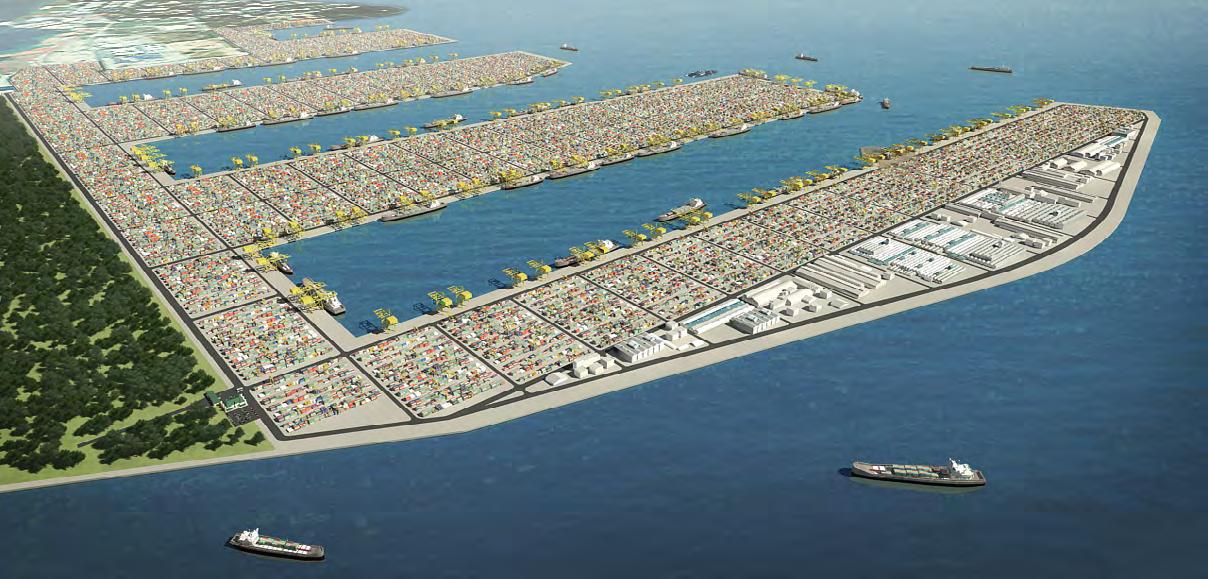
18 minute read
Singapore’s next-generation port
Tuas Port will be a resilient and sustainable marine transportation hub.
Artist’s impression of Tuas Port, Singapore’s next generation port.
INTRODUCTION
In order to maintain Singapore’s position as a global hub port and an international maritime centre, Singapore has been investing in its port capacity and capabilities ahead of demand. Over the years, the port capacity has expanded from the first container terminal at Tanjang Pagar to also include Keppel Terminal, Brani Terminal and Pasir Panjang Terminal. First announced in 2012, Singapore’s plan is to consolidate container port operations from the current terminals to a single location at Tuas at the western end of the country. The vision is to build a smart, next-generation port that increases productivity, optimises land use, improves safety and security, and enhances sustainability. When fully completed in the 2040s, Tuas Port will be capable of handling up to 65 million Twenty-foot Equivalent Units (TEUs) annually. Consolidating all container-handling facilities at Tuas will significantly reduce inter-terminal haulage operations and greenhouse gas (GHG) emissions while achieving greater economies of scale. The Maritime and Port Authority of Singapore (MPA) has planned the development of Tuas Port in four phases. The land reclamation work under Phase 1 commenced in March 2015 and MPA is on track to complete Phase 1 land reclamation works by the end of 2021. Phase 2 reclamation works for Tuas Port are ongoing as scheduled.

Aerial view of the Tuas Port site as at early January 2021.
Stolz Engineering Pte Ltd (Stolz Engineering) was honoured as one of winners of the Enterprise 50 Awards (E50 Award) for 2020, in recognition of the company’s enterprising spirit. Mr Mark Tan, Managing Director, Stolz Engineering, and a former Council Member of IES, believes that engineers make great entrepreneurs because they bring a skillset to the startups, that has been developed over years of managing projects and solving problems. Commenting on the award, he said, “The E50 Award is a true testament of the years of hard work and contributions from my team alongside the valuable collaboration with our clients and partners, and without which Stolz would not have been able to achieve this pivotal recognition”. “A key company initiative, that has proven successful over the years, is the continuous training and development of our dedicated team members. I am an advocate of providing equal opportunities and training platforms, because a well-equipped and skilled team will be a team that can manage projects confidently and smoothly to ensure client satisfaction”, Mr Tan added. “At Stolz, we don’t control quality, we produce quality. ‘Stolz’ is the German word for ‘pride’ which underlines our attitude to work. We strive for pre-eminence in our work standards”, he continued. The E50 Awards is jointly organised by The Business Times and KPMG in Singapore, and sponsored by OCBC Bank. Supporters of the awards include Enterprise Singapore, the Singapore Business Federation and Singapore Exchange.
COMPANY HISTORY
Stolz Engineering specialises in cooling tower technologies and equipment. The company is backed by an expert team of colleagues focused on delivering high-performance products and services, ranging from standard factory-assembled systems to custom-made solutions for clients. Stolz Engineering was founded in 2007 by Mr Tan who had previously worked in multinational corporations (MNCs) for about 10 years, in the design, operation and sales of cooling systems.
CHALLENGING START
Soon after its establishment, Stolz Engineering had to face the effects of the global financial crisis of 2008, which included the cancellation of projects. However, the company successfully overcame the obstacles, with strategic decisions on streamlining the business and adapting it to the new realities.
STEADY GROWTH
Stolz Engineering has grown steadily over the years. The company is the official sole distributor, in Singapore, of the well-known Marley cooling towers. Marley is part of SPX Cooling Technologies Inc, a leading global manufacturer of cooling towers and air-cooled condensers, providing full-service cooling solutions to, and supporting customers in, the power generation, petrochemical, manufacturing, refrigeration, and HVAC markets, for more than 100 years. In turn, SPX Cooling Technologies is part of SPX, a US-based global Fortune 500 multi-industry manufacturing company. Stolz Engineering has provided innovative cooling tower solutions to iconic projects such as Gardens by the Bay, Resorts World Sentosa and Singapore Sports Hub.
FUTURE DIRECTION
The company has outlined a few key goals, going forward. They include the following: • Being at the forefront of research and development, in order to provide industries with innovative, superior and cost-effective solutions. • Continuing to stay ahead of the curve, by embracing the latest trends and cutting-edge technologies, whilst being, at the same time, environmentally sustainable, particularly in terms of water conservation and waste reduction. • Equipping the existing Stolz team with more specialised skills and training, so that they have the confidence to carry out their work professionally and responsibly. • Cultivating talent and giving back, by mentoring, coaching and being a resource to budding entrepreneurs of the next generation.

The master planning for Tuas Port includes the planning of the port layout, water depth, navigation channel and anchorages to serve the port and the port eco-system and other objectives. The reclamation work in Phases 1 and 2 of the Tuas Port project involves the creation of 681 hectares (ha) of reclaimed land, fabrication of 448 caissons and the dredging of the Temasek Fairway and Tuas Basins to a depth of -23 m at Chart Datum (CD). Finger-piers with caisson quay walls were adopted to maximise limited land and sea space. Coupled with long linear berths and a design depth of -23 m at CD, Tuas Port will be able to accommodate mega container ships exceeding 450 m in length.
Sustainability
Sustainability is at the heart of the planning, design, construction and operations of Tuas Port. It will be a green port, which is economically and environmentally sustainable with energy-efficient processes and a safe and clean environment. Many environmentally friendly initiatives were considered in developing Tuas Port. To adapt to rising sea levels, Tuas Port will be built at least 5 m above mean sea level to future-proof it against sea level rise in the coming decades. More than 50% of the total fill materials for Phases 1 and 2 are dredged and excavated material from local construction projects. Reusing such material, which would otherwise be disposed of, reduces the reliance on sand for reclamation and saves more than SGD 2 billion in fill material costs, apart for constructing Tuas Port in a sustainable manner. Environmental impact assessments were carried out before reclamation works, which resulted in preventive and mitigation actions such as implementing a SGD 6 million programme to relocate and monitor corals that may be affected during Tuas Port development. The community was encouraged to be guardians of the ecological environment in the waters off Tuas Port. Corals in proximity to the port development were relocated with the help of nature volunteers, and environmental monitoring of the relocated corals was carried out by established academics in the National University of Singapore (NUS). These efforts have helped to raise public awareness and promote community participation in protecting the environment. Strict Environmental Quality Objectives for compliance during the reclamation works were also established to protect marine habitats and sensitive commercial water intakes under the on-going Environmental Monitoring and Management Programme (EMMP).
Digitalisation
Beyond the physical port, Tuas Port will use automated technology, boasting features such as automated wharf and yard functions and fully electric automated guided vehicles. Tuas Port will be highly digitalised, with the use of a state-of-the-art vessel traffic information system, an active anchorage management system and digitalPORT@ SG™ to efficiently manage the shipping traffic. The digitalPORT@SG™ is a one-stop portal for port clearances and other regulatory transactions as well as Just-InTime services to enhance efficiency of port operations and improve the turnaround time of ships. digitalPORT@SG™ will also be integrated with port and marine service providers to facilitate a marketplace for seamless access to services for customers and port users. The digital port ensures sustainability in terms of eco-efficiency, by endeavouring to minimise vessel and land vehicle movements, reduce idling time and streamline maritime processes. Consequently, the operational efficiencies gained would reduce emissions at the port, its surrounding eco-system and beyond our port waters. In addition, Tuas Port will utilise advanced communication networks to support IoT, automation and digitalisation, and deploy innovative technologies such as data analytics and artificial intelligence in decision-making. Tuas Port will also be at the heart of a larger eco-system in the industrial hinterland. This will create greater port-industry synergies that will strengthen the link between the port and businesses, and will reduce the logistics costs. Under the larger Tuas eco-system, MPA, together with other agencies, has developed measures to be implemented in tandem with the ramping up of port operations at Tuas to ensure the accessibility of Tuas Port for its workers. Clustering synergistic industries in a port-centric eco-system around Tuas Port offers carbon footprint savings through shortened supply chains, shared facilities, and resource optimisation.
MPA receives accolade at World Ports Sustainability Awards
At the International Association of Ports and Harbors’ (IAPH) World Ports Sustainability Awards 2020, Tuas Port won the award in the ‘Port Development and License to Operate’ Focus Area, under the ‘Community Outreach & Port City Dialogue’ category. The accolade recognises the efforts of the Maritime and Port Authority of Singapore (MPA) in ‘aligning and integrating port and community objectives for the betterment of both’. These efforts include developing community engagement programmes and managing the externalities of port expansion in urban environments. Er Tham Wai Wah, MPA’s Chief Engineer and Senior Director (Engineering and Project Management), said, “Tuas Port represents a bold vision for Singapore. As a responsible hub port, this award affirms our commitment to balance environmental protection with port development. It is our ambition for Tuas Port to become a beacon for sustainability, safety and efficiency”.
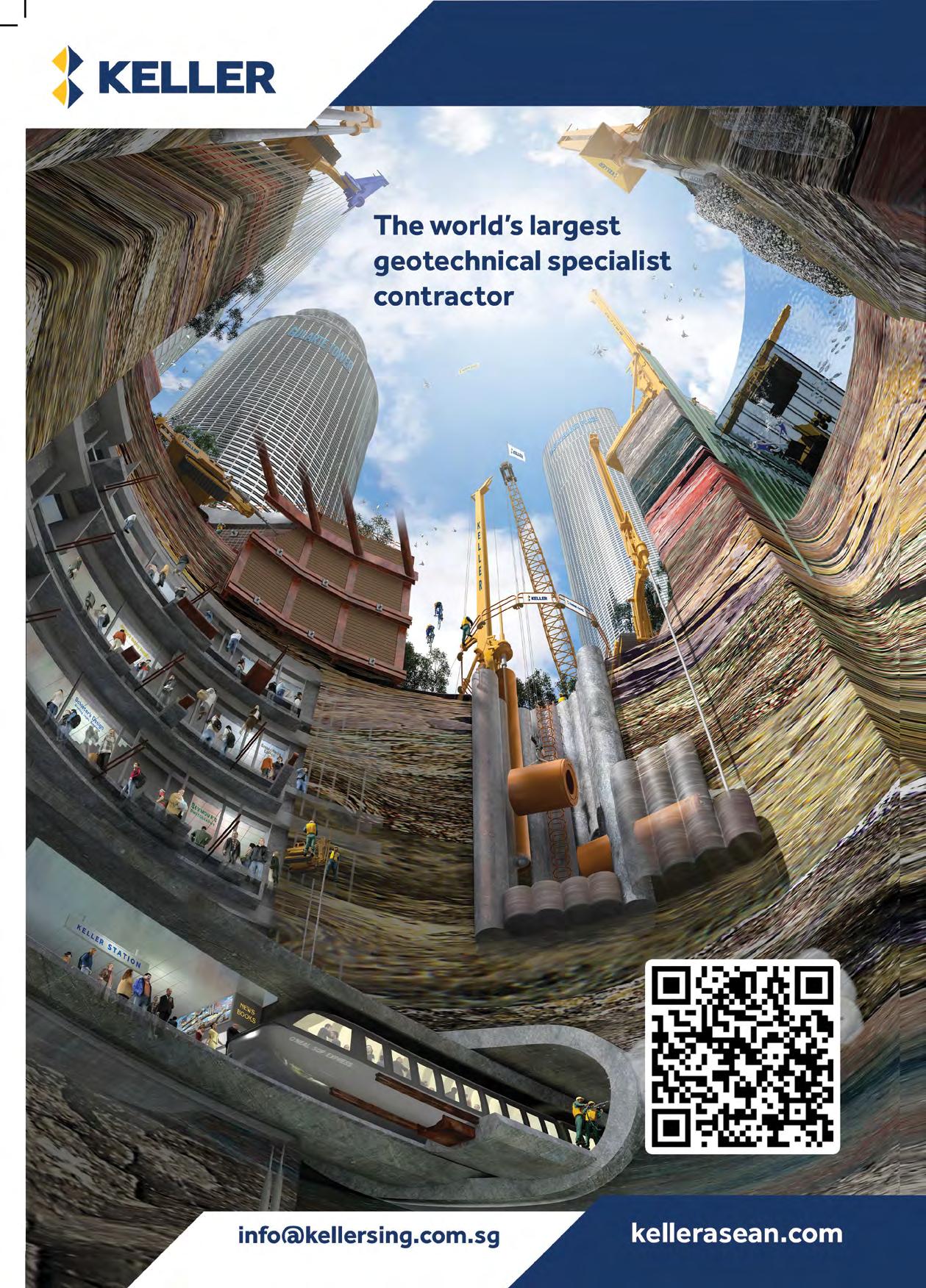
Maritime and Port Authority of Singapore
The Maritime and Port Authority of Singapore (MPA) was established on 2 February 1996, with the mission to develop Singapore as a premier global hub port and international maritime centre (IMC), and to advance and safeguard Singapore's strategic maritime interests. MPA is the driving force behind Singapore's port and maritime development, taking on the roles of Port Authority, Port Regulator, Port Planner, IMC Champion, and National Maritime Representative. MPA partners the industry and other agencies to enhance safety, security and environmental protection in our port waters, facilitate port operations and growth, expand the cluster of maritime ancillary services, and promote maritime R&D and manpower development.

TUAS PORT PHASE 1 CONSTRUCTION
Tuas Port Phase 1 construction commenced in end-April 2016, with the launch of the first caisson. In February 2015, MPA appointed the DIAP-Daelim Joint Venture to carry out the land reclamation and related works for Tuas Port Phase 1 development. The works include reclaiming 294 hectares of land, dredging the Tuas basin and Temasek Fairway, as well as constructing the wharf structure.
Innovative engineering solutions
The scale and complexity of the project presented opportunities for the team of MPA and local as well as international engineers to challenge themselves and find innovative solutions to overcome resource constraints. One such challenge was the construction of the wharf structure, which saw the engineering teams use an innovative caisson design with the caissons prefabricated on site.

Grab dredgers are used to dredge the seabed and the dredged materials are used as reclamation fill.
From left: Filling of dredged materials into the final caisson with an e-crane to lock its position and celebratory water cannons from tugboats to mark the last caisson installation in Tuas Port Phase 1.
The reclaimer is a specialised equipment that is used to fill the soft dredged materials above the water surface, such as filling across the caisson wharf line.

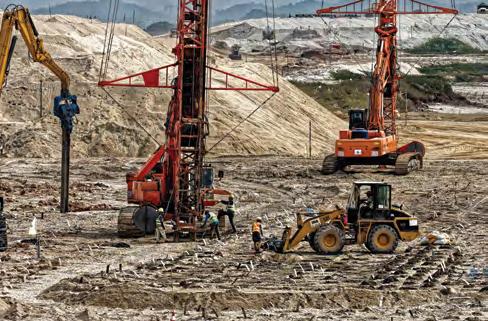
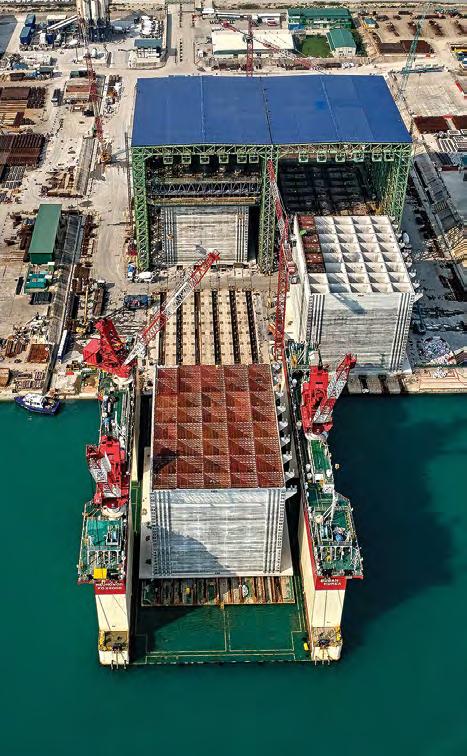
Soil improvement using pre-fabricated vertical drains (PVDs) with sand surcharge has been adopted to improve the recycled fill materials which are soft clayey soils and the existing soft clayey seabed materials.
The use of caissons is a more efficient method of construction than other methods such as piling, and affords site personnel a safer work environment. In addition, as the caissons are of standard sizes and prefabricated in a factory-like environment on-site, productivity and the quality of the wharf structure are also improved. The caissons used for Tuas Port’s construction are one of the largest in the world. Pre-fabricated onsite, each caisson weighs 15,000 tonnes and measures 40 m in length, 28 m in width and 28 m in height. The DIAP-Daelim Joint Venture has also used cutting-edge equipment and techniques to maximise efficiency. It mobilised the world’s largest grab dredger and one of the world’s most powerful cutter suction dredgers, along with a wide range of other dredging and reclamation equipment. In addition, the use of soil improvement techniques allowed the dredged materials from the deepening of basins and nearby fairway, as well as excavated earth obtained from other land construction projects, to be reused as reclamation fill materials for the project. Re-using such materials, which would otherwise be disposed of, reduces the quantity of sand fill required for reclamation, resulting in fill material cost savings. A total of 221 caissons form the permanent wharf structure. The final caisson for Tuas Port Phase 1 reclamation was installed in late April 2019. MPA, together with their partners DIAP-Daelim Joint Venture, Surbana Jurong, YJP surveyors and Xjera also adopted other innovative solutions, ranging from the pre-installation of geotextiles on caissons on land instead of at sea and test-bedding the use of video analytics with artificial intelligence for site safety, to the use of drones with Lidar capabilities for site survey and progress monitoring. In addition, there are two innovations that have pushed the frontiers of engineering: • The deployment of TEMAROCK, a next-generation, allin-one rock mound construction vessel: The conventional process of rock mound construction requires multiple vessels for rock laying and compaction, one survey vessel to facilitate operation, and support by


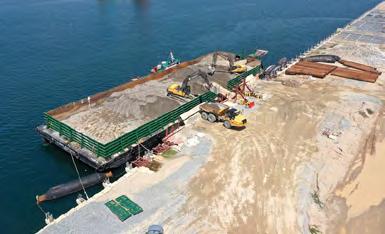

divers. TEMAROCK automates these tasks, eliminating the need for multiple vessels or assistance from divers.
This enhances efficiency and safety. • The use of the Automatic Rebar Machine Systems (ARMS) which employs robotics: ARMS automates the bending and cutting of reinforcement steel bars (rebars), which are used to strengthen concrete, to the desired design, and then transfers them to the stacking area. The conventional practice requires workers to handle the rebar manually, which exposes them to mechanical hazards when they operate the rebar cutting and bar bending machines. With the completion of Phase 1 reclamation works in 2021, PSA, the operator of the port, expects to commence operations of the first set of berths by the end of this year.
TUAS PORT PHASE 2
The reclamation work for Tuas Port Phase 2 commenced in early July 2019, with the installation of the first caisson. When fully operational, Tuas Port Phase 2 will add a capacity of 21 million twenty-foot equivalent units (TEUs). MPA appointed Penta-Ocean Construction Co. Ltd/ Hyundai Engineering & Construction Co Ltd/Boskalis International BV (PHB) Joint Venture to carry out land reclamation and related works for Tuas Port Phase 2 development in February 2018. At 387 hectares, this is the largest of the four phases to be reclaimed. The 8.6 km wharf structure will be constructed with 227 caissons that will be fabricated on site.
The use of innovative and modern construction methods
The Tuas Port Phase 2 project team is using innovative construction methods to boost safety and improve productivity. For example, the project team is using a slip form jack monitoring system and rebar modularisation, for the fabrication of the caissons. The slip form jack monitoring system provides an unobstructed view of the hydraulic system. This feature enhances the safety of workers through prompt rectifications of the hydraulic system. The process of rebar modularisation allows for the pre-fabrication of steel bars that form part of the base slab. This significantly improves the safety of those working under the steel bars. The project team is also adopting modern construction technology such as an automated curing system which is a water circulation system that helps to control the quality of the base slab. In addition, there is one innovation that has enhanced construction safety: • The deployment of the unmanned silane sprayer,
Silane Apache, for the application of silane on internal concrete walls of the caisson and Silane Alpinist, for the application on external concrete walls: The conventional process required workers to use a single hand nozzle sprayer while working at height in a suspended man cage or boom lift basket. Silane Apache and Silane Alpinist automated these tasks, eliminating the risk of accidents from working at height and reducing the exposure of workers to toxic fumes. This enhances productivity and safety. Furthermore, the project team is using modelling and simulation techniques to simulate numerous construction activities at the reclamation sites to assess congestion hotspots for trucks on land and vessels in the sea, which could be potential risk areas for accidents. This allows the Contractor to better plan, schedule and allocate resources to move construction and reclamation fill materials around safely and efficiently on site.
Innovation Initiatives and Research and Development (R&D) Efforts
Currently, there is no existing knowledge on the performance of reclaimed port land with large-scale use of dredged and excavated materials to support automated container terminal operations. Together with a team of NUS researchers, engineers from MPA and PSA Corporation are developing a digital twin of the Tuas Port reclaimed land (DigitaLand@Tuas) using fundamentals of soil mechanics and machine learning optimisation techniques. DigitaLand@Tuas could help to identify susceptible areas within the container terminal where and when stringent allowable ground settlement may be reached, and automated operations could be affected.
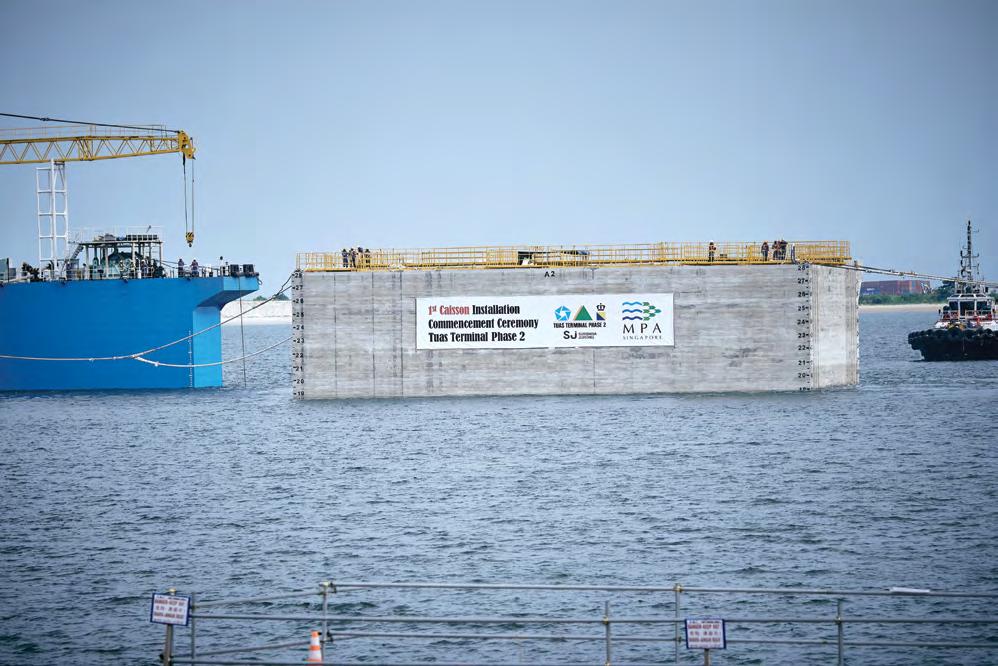
With this predictive ability, PSA’s engineers can plan preventive maintenance early to repair a potential area of excessive settlement and reinstate the port pavement to its required level, if necessary. If this R&D is successful, this innovation would help the port operator to better predict long-term settlement behaviour and mitigate the risks of hampering productivity of terminal operations due to frequent closure of yards and berths for repair and maintenance works over the long term. MPA is also partnering a team of Nanyang Technological University (NTU) researchers to study the use of controlled modulus columns (CMC) as a foundation to support heavy container stacks in storage yards. Upon demolition, CMCs are easier to remove than conventional steel reinforced concrete piles. If the R&D pilot trial of CMC is successful, CMC could be a better alternative for constructing foundations for container yards to future proof the port. In addition, MPA is also working with NTU and DHI Singapore to deploy video analytics for silt plume detection in coastal waters around Tuas Port. Drones with hyperspectral and multispectral cameras will carry out remote sensing to monitor turbidity concentrations in the waters. Using Artificial Intelligence with Convolutional Neural Networks imaging analysis, the software will be able to put together a contour map of turbidity concentration of the silt plume. This R&D project complements the on-going EMMP which uses real-time sensors to monitor the impact of dredging and reclamation works on the marine environment. If successful, this project will help to digitalise environmental monitoring operations in Singapore waters and gives near real-time information to optimise allowable spill budgets for reclamation work.
All images by Maritime and Port Authority of Singapore
PROJECT CREDITS (EARLY STAGE DEVELOPMENT)
DEVELOPER
MARITIME AND PORT AUTHORITY OF SINGAPORE (MPA)
SITE INVESTIGATION WORKS
KISO JIBAN CONSULTANTS CO LTD
ENVIRONMENTAL IMPACT ASSESSMENT AND CORALS RELOCATION WORKS
DHI WATER & ENVIRONMENT (SINGAPORE) PTE LTD
CONCEPTUAL AND PRELIMINARY ENGINEERING OF TUAS TERMINAL GATEWAY
ONG & ONG PTE LTD
LAND TRAFFIC IMPACT ASSESSMENT
VERTIX ASIA PACIFIC PTE LTD
SPACE INTENSIFICATION STUDIES
SURBANA JURONG CONSULTANTS PTE LTD
MARINE RISK ASSESSMENT
SIMPLUS PTE LTD
PROJECT CREDITS (CONSTRUCTION STAGE)
DEVELOPER
MARITIME AND PORT AUTHORITY OF SINGAPORE (MPA)
TPP1 MAIN -CONTRACTOR
DIAP-DAELIM JOINT VENTURE - MAIN CONTRACTOR (PHASE 1)
TPP2 MAIN -CONTRACTOR
PENTA-OCEAN CONSTRUCTION CO LTD./ HYUNDAI ENGINEERING & CONSTRUCTION/ROYAL BOSKALIS WESTMINSTER N.V. JOINT VENTURE (PHBJV) - MAIN CONTRACTOR (PHASE 2)
TPP1 AND TPP2 SUPERVISION CONSULTANT
SURBANA JURONG CONSULTANTS PTE LTD
TPP1 AND TPP2 CONSULTANTS AND CONTRACTORS
T.Y. LIN INTERNATIONAL PTE LTD KISO-JIBAN CONSULTANTS CO LTD ALLIANCE CONCRETE SINGAPORE PTE LTD RIBAR INDUSTRIES PTE LTD SNKTC ENGRG & TRADING PTE LTD EAST MARINE PTE.LTD TG GLOBAL RESOURCES PTE LTD TENCATE GEOSYNTHETICS SINGAPORE PTE LTD COFRA B V SINGAPORE BRANCH SING TEC DEVELOPMENT PTE LTD KELLER FOUNDATIONS (SE ASIA) PTE LTD GEOMOTION (SINGAPORE) PTE LTD APS ASIA PDA ENTERPRISE PTE LTD YI HONG CONSTRUCTION PTE LTD RYOBI GEOTECHNIQUE INTERNATIONAL PTE LTD CAK & FG SURVEY PTE. LTD. GOLDEN EMPIRE-HUATIONG PTE. LTD. DONG-A CONSULTANTS ASIA PTE LTD ECK SHEN CONSTRUCTION & TRADING PTE LTD IMPROTECH PTE LTD INTELQUIP PTE LTD HIAP SENG PILING CONSTRUCTION PTE LTD BACKHO (S) PTE LTD DONGWOON ENGINEERING PTE. LTD. HIAP SENG PILING CONSTRUCTION PTE LTD INA HEAVY MACHINERY & EQUIPMENT PTE LTD INA ENGINEERING & CONSTRUCTION PTE LTD DONGWOON ENGINEERING PTE. LTD. KOK KIAT MACHINERY PTE LTD DONG-A CONSULTANTS ASIA PTE LTD JACK ENTERPRISE PTE. LTD. YORK LAUNCH SERVICE PTE LTD KEE MARINE PTE. LTD. PRIME FORCE ENGINEERING & CONSTRUCTION PTE LTD HYUNDAI ENGINEERING & CONSTRUCTION HEUNGWOO INDUSTRIAL CO. LTD. (SINGAPORE BRANCH) DAELIM INDUSTRIAL CO. LTD. COMPACTION ENGINEERING PTE LTD DREDGING INTERNATIONAL ASIA PACIFIC PTE LTD KONIS. PTE. LTD. SOON KON CONSTRUCTION COMPANY WORLEY PTE LTD FUGRO SINGAPORE MARINE PTE LTD MARCHWOOD LABORATORY SERVICES PTE LTD ABL CONSULTANTS PTE LTD PH CONSULTING PTE LTD JIB SPECIALIST CONSULTANTS PTE. LTD. ENGINEERS 2002 (PTE) YJP SURVEYORS PTE LTD XJERA LABS PTE LTD




